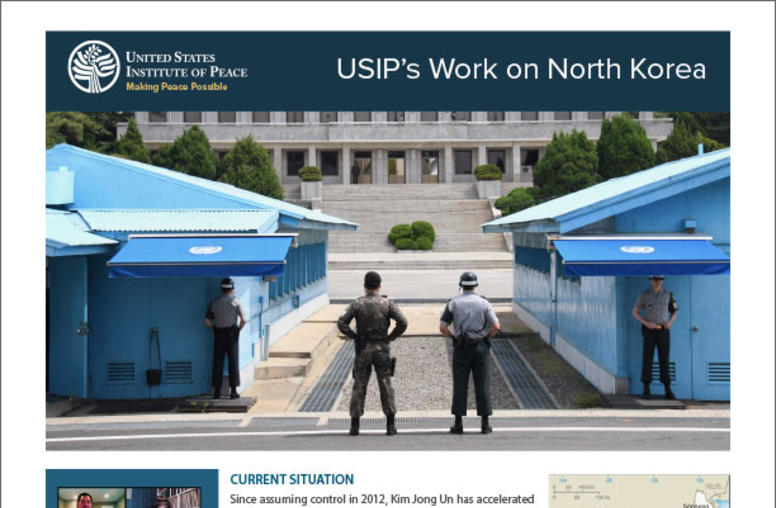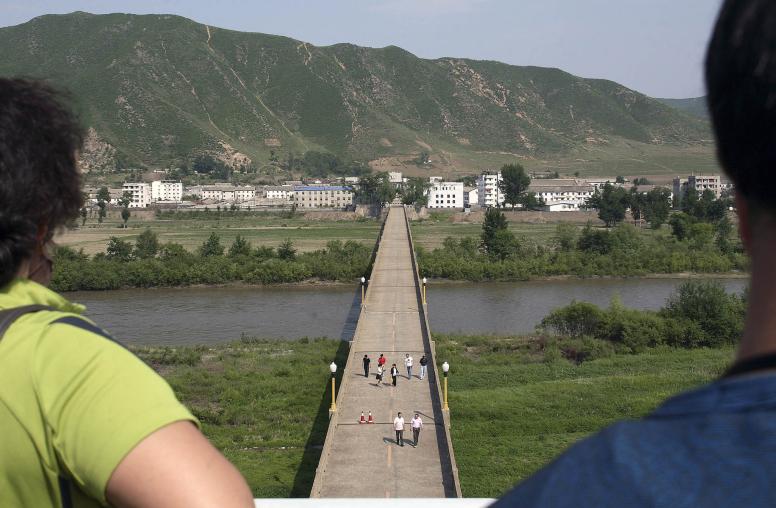On to Vietnam: What Will Happen at the Second Trump-Kim Summit?
The U.S. has signaled a shift in policy toward North Korea that could lead to more substantive outcomes
At the State of the Union address this week, President Trump announced that he will again meet with North Korean leader Kim Jong Un at the end of February in Vietnam for their second face-to-face negotiations. The president’s announcement follows recent comments from U.S. Special Representative for North Korea Stephen Biegun indicating that the U.S. is prepared to negotiate on both denuclearization and peace simultaneously—an approach that the Trump and former administrations previously eschewed. Negotiations have been stalled for months, as Washington had demanded that North Korea take significant denuclearization steps first before the U.S. would provide sanctions relief and other incentives, while Pyongyang instead sought a more reciprocal process with corresponding measures taken by both sides in parallel. USIP’s North Korea and China experts examine the potential shift in U.S. policy and what concerns key regional players have over the next summit.

What did we learn from U.S. Special Representative for North Korea Stephen Biegun’s recent remarks on U.S. policy toward North Korea that could lead to a more successful follow up summit?
Aum: In his remarks, Biegun mentioned several things that demonstrate positive signals from both North Korea and the United States.
First, he indicated that Kim Jong Un told Secretary Pompeo privately that North Korea would not only permanently dismantle its Yongbyon facility (as described in the September inter-Korean Pyongyang Declaration) but would dismantle the entirety of its nuclear program in exchange for appropriate corresponding measures. Of course, this is meaningless without tangible action, but it is still a helpful indicator—messaged directly from Kim to Pompeo without South Korean President Moon as an intermediary—about the scope of Kim’s commitment to denuclearization.
Second, Biegun claimed that Washington was prepared to have negotiations on both denuclearization and peace simultaneously and in parallel. In the past, the Trump administration and previous U.S. administrations have insisted on securing North Korean denuclearization steps first before agreeing to discuss a peace regime. Putting peace regime negotiations on the table upfront is a significant shift in U.S. policy that could engender greater concessions from Pyongyang.
Third, Biegun said that in the working-level negotiations in advance of the February 27-28 summit, his intention was to achieve "a set of concrete deliverables, a roadmap of negotiations, and declarations going forward.” It's unclear whether he meant an end-of-war declaration could be made at the summit or just an announcement that a declaration could be made in the future contingent on North Korean actions. Still, the State Department has been supportive of the concept of an end-of-war declaration—Biegun noted in his talk that “President Trump is ready to end [the Korean War]. It is over. It is done”—so it wouldn't be implausible for a declaration to occur at the summit in Vietnam.
Fourth, Biegun explained that the administration's unwillingness to remove sanctions until denuclearization is complete doesn't mean that it wouldn't do anything until North Korea does everything. In other words, he is opening up the possibility that the U.S. could take initial sanctions relief measures, including waiving sanctions against the Kaesong Industrial Complex, the Mt. Keumgang tourism project, and inter-Korean railway cooperation, if North Korea takes appropriate denuclearization steps.
And fifth, he stated unequivocally that U.S. troop reductions are not on the table at the moment. There has been some concern about this possibility given President Trump’s displeasure about the cost of stationing U.S. troops in South Korea, his request last year for a review of U.S. troop presence in South Korea, and his actions on Syria and Afghanistan. Although the FY19 National Defense Authorization Act prevents the Pentagon from going below 22,000 U.S. troops in South Korea without a certification from the secretary of defense that this move would be in the national interests of the United States and that our allies were appropriately consulted, this also implies that the Defense Department could reduce troops from the current 28,500 to 22,000 without these certifications.
Of course, given the long track record of diplomatic failure on North Korea, we need to remain cautious. Nevertheless, Biegun's remarks are encouraging after the last half-year of stalled negotiations.
Why is the U.S. now willing to pursue negotiations on denuclearization and peace simultaneously, after the Trump and previous administrations have refused to do so? What developments, or lack thereof, led to such a major policy shift?
Stokes: For roughly the first year of the Trump administration, U.S. policy presumed that Washington would be able to use a pressure campaign made up of sanctions, diplomatic isolation, and the threat of military force to coerce Pyongyang into unilateral denuclearization. That approach envisioned a relatively narrow deal that would trade sanctions relief for North Korea relinquishing its nuclear arsenal. The thinking went that, with the nuclear threat addressed, the parties could then move toward negotiating peace as a second step. A denuclearization-first approach sought to address the nuclear and missile threat directly and avoid what some viewed as the potential to be sidetracked by other issues.
Strict adherence to a single-track, sequential process started to soften last year amid fast-moving diplomacy on the Peninsula. Now, as Special Representative Biegun’s remarks make clear, the Trump administration has officially adopted a dual-track, simultaneous approach to negotiations. Discussing both denuclearization and peace simultaneously widens the aperture of the talks, incorporating up front more of the issues North Korea wants to address in a comprehensive agreement.
A confluence of factors prompted the change in approach: U.S. officials appear to have accepted that North Korea considers denuclearization and peace to be inextricably linked and concluded a dual-track process is more likely to elicit cooperation from Pyongyang. Progress in inter-Korean diplomacy, which is more focused on the peace track, generated diplomatic momentum that all the parties are interested in sustaining. Last year’s Trump-Kim summit in Singapore provided a leader-level mandate to advance comprehensive diplomacy, and the new approach better reflects that mandate. President Trump’s announcement of a second summit with Kim Jong Un at the end of this month adds additional impetus for a major agreement. And, less positively, meager substantive progress on denuclearization since the summit likely forced an evolution in the U.S. approach to avoid the process breaking down.
Given that negotiations have been stalled since the previous Trump-Kim summit, what do regional players (South Korea, China, Japan, Russia) expect from the next round of negotiations? What major concerns do they have?
Kim: As the next Trump-Kim summit looms, all of the regional players are watching closely to see how negotiations will proceed. Seoul is naturally most invested in sustaining momentum for the diplomatic track given the future of the Korean Peninsula is at stake. Since negotiations stalled following the first Trump-Kim summit, the Moon administration has tried to mediate between Pyongyang and Washington, and has sought to walk the fine line of advancing inter-Korean relations while staying aligned with the United States’ policy that sanctions must remain in place until North Korea takes concrete steps to denuclearize.
South Korean conservatives, on the other hand, have raised the alarm that Seoul and Washington are being tricked into weakening the U.S.-ROK alliance and granting concessions to Pyongyang, which according to many experts—including the U.S. intelligence community—has no intention of giving up its nuclear weapons. Likewise, Japanese observers are concerned that Washington might rush toward a deal with Pyongyang that addresses only the intercontinental ballistic missile threat against the U.S. homeland while leaving Japan and South Korea vulnerable to North Korea’s short and medium-range missiles.
Biegun’s recent remarks sought to reassure both the skeptics and the pro-engagement camp. He highlighted the unprecedented top-down approach to negotiations and stressed Trump and Kim’s personal commitments to make progress, and lauded the efforts being made to advance inter-Korean relations, including military tension reduction measures at the DMZ. At the same time Biegun also emphasized that the United States remains committed to pursuing the “final, fully verified denuclearization” of North Korea, and that U.S. troop withdrawals are not on the negotiating table as a bargaining chip.
Biegun’s remarks were also most likely welcomed in Beijing given his emphasis on Washington’s intentions to work simultaneously with Pyongyang on the objectives of “transforming relations,” “establishing a permanent peace regime,” and “complete denuclearization.” Chinese leaders have long advocated for the United States and North Korea to engage in parallel negotiations toward denuclearization and a peace treaty, as opposed to pursuing the former before the latter. In addition, given Beijing’s general desire for stability in its neighborhood and its consumption with the ongoing U.S.-China trade war, Chinese leaders are likely relieved to see that a return to the “fire and fury” days are unlikely and that the United States and North Korea will remain tied down in a drawn-out negotiating process.
As negotiations proceed and the terms of a peace regime are worked out, Beijing will undoubtedly support Pyongyang as it pushes for the elimination of U.S.-ROK military exercises and banning the deployment of U.S. strategic assets to the Peninsula, as Kim recently demanded in his New Year’s address. As the regional players work toward a viable peace regime on the Korean Peninsula, they will need to grapple with these and many other complex and conflicting interests.



